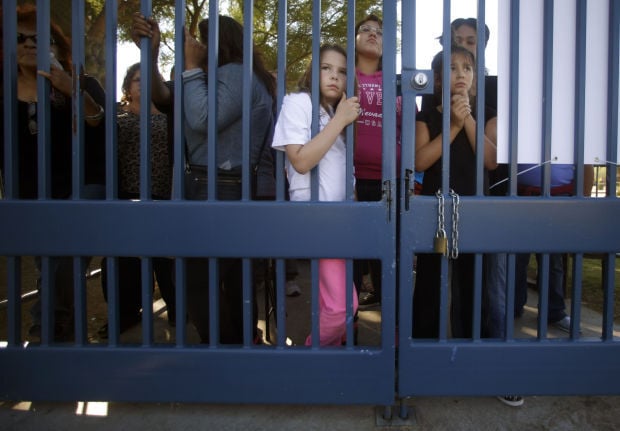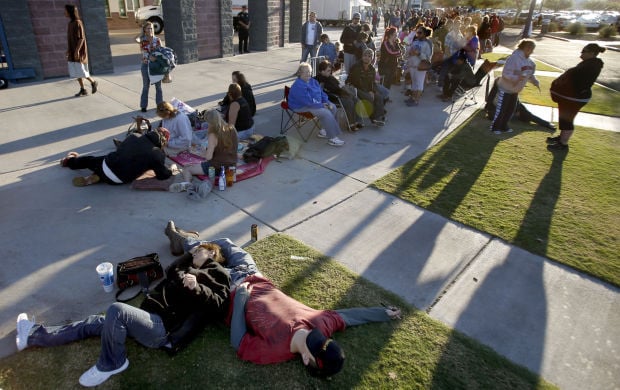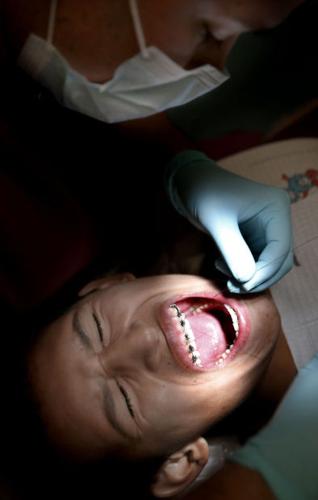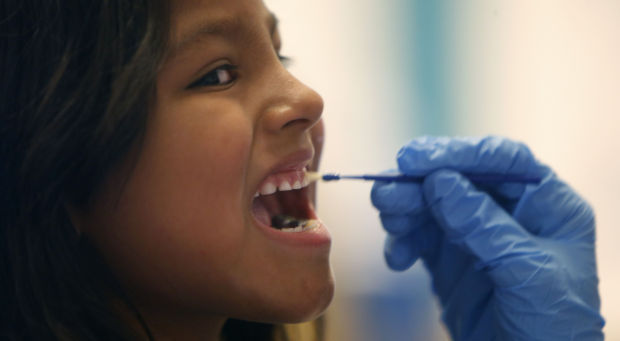The line was hundreds deep by 5 a.m., a full four hours before TucsonŌĆÖs only charity dental event began.
No overnight camping was allowed but some did it anyway. Ages ranged from infants to seniors, but those in line had one thing in common ŌĆö none felt they could afford dental care. There were people in their 30s missing teeth, seniors with gum disease, and children with unfilled cavities.
Tempers flared when a volunteer, accompanied by security guards, told those at the back of the line they would not be able to get help this time.
Nearly one-quarter of Tucson-area residents lives in poverty, and it shows in their teeth. Poor oral health sends people of all ages to the emergency room with infected abscesses, and people without dental care are vulnerable to heart and kidney disease, diabetes, high blood pressure and even premature death.
People are also reading…
The problem is a common one here. Tucson is among the six largest 50 cities in the country that does not fluoridate its water or have enough naturally occurring fluoride to prevent cavities, according to a federal analysis. Medicare, which is government insurance for seniors, does not include dental coverage, and fewer than 1 percent of the health plans sold through the Affordable Care ActŌĆÖs federal marketplaces include adult dental care, the national ChildrenŌĆÖs Dental Health Project says.
In 2008, the Arizona Legislature eliminated preventative dental services to Arizona Medicaid enrollees with intellectual and developmental disabilities, and to seniors who were both eligible for Medicaid and clients of its Arizona Long Term Care Services program.
ArizonaŌĆÖs Medicaid program, a government health insurance program for low-income people, has never offered comprehensive dental coverage to adults, though it did once cover emergency dental and medically necessary dentures for adults 21 and older.
But because of state budget slashing, Medicaid in Arizona, which is called the Arizona Health Care Cost Containment System (AHCCCS), has not provided emergency dental coverage or dentures to adult enrollees older than 21 since Oct. 1, 2010.
The exception is medical and surgical dental services that could be considered a ŌĆ£physician service,ŌĆØ for a condition such as a fractured jaw or infection.
The AHCCCS cuts appear to have resulted in a spike in emergency-room visits.
Emergency-room treat-and-release visits for oral health problems in the state jumped by 29 percent between 2009 and 2011, data from the Arizona Department of Health Services shows. The number of emergency room cases where oral health was the primary or secondary reason for inpatient admission jumped by 37 percent in that same time period, the Arizona-based Adult Benefit Coalition for Dental Care says.
A lack of coverage for low-income pregnant women is particularly concerning to health advocates because nearly one quarter of Arizonans, including the mothers of more than half the babies born here last year, get their health-care from AHCCCS. Gum disease can be passed to an unborn child, causing prematurity and illness.
Education and policy changes could improve oral health in Arizonans. Among the ideas: including adult dental care in ArizonaŌĆÖs Medicaid program coverage, allowing a new type of mid-level provider called a dental therapist to ease a provider shortage, fluoridating tap water and cleaning the teeth of patients in hospital intensive care units ŌĆö a measure that could reduce infections and deaths among critically ill patients, since bacteria can grow on breathing tubes, leading to ventilator-associated pneumonia.
Not early enough
OctoberŌĆÖs HopeFest, held at Kino Stadium in Tucson, could help only 600 of the thousands of people who sought free dental care. Wristbands were given on a first-come first-serve basis and many left disappointed. Yolanda Hernandez left holding the hand of her son, 27-year-old Diego Santiago, who has Down syndrome. They arrived more than two hours before the event began, but that wasnŌĆÖt early enough.
Santiago, who clutched a balloon as his mother asked for help, has health insurance through Medicaid. But under AHCCCS, he does not qualify for dental benefits because he is older than 21, despite the fact he has a disability.
Nine-year-old Brionna Baker sobbed as she stood in line with her aunt, grandmother and her 10-year-old neighbor and friend, Madison Bricker. BrionnaŌĆÖs family earns too much to qualify for AHCCCS, but not enough to pay for dental care.
The family arrived at HopeFest at 2 a.m. and by 8:30 a.m. Brionna was hungry and upset at the arguing around her as officials started turning people away.
Nearly one quarter of Arizona children ages 1 through 17 has at least one oral health problem such as toothaches, cavities, broken teeth and bleeding gums, the Oregon-based Data Resource Center for Child & Adolescent Health says. The surveyŌĆÖs state-by-state ranking on oral health problems in children places Arizona toward the bottom of the 50 states and the District of Columbia, ahead of only New Mexico and Mississippi.
ŌĆ£Covering kids is relatively inexpensive and easy to do,ŌĆØ said Dr. Daniel Derksen, a professor at the University of ArizonaŌĆÖs Mel and Enid Zuckerman College of Public Health and director of its Center for Rural Health. ŌĆ£But itŌĆÖs a challenge to really make sure those who are most vulnerable are getting preventive services.ŌĆØ
While events like HopeFest in Tucson are helpful, dental care needs to be accessible, available and affordable every day, Derksen said. But the opposite is happening: Arizona has eliminated enrollment in KidsCare, a federal health insurance program for children whose parents earn slightly more than the Medicaid cutoff. That program included dental coverage.
Also, the state had higher-than-average standalone dental premiums for children in the U.S. during the 2013-14 enrollment season, a survey by the national ChildrenŌĆÖs Dental Health Project says. ŌĆ£We donŌĆÖt need to settle for kids losing their teeth before they start grade school and high school. ItŌĆÖs unconscionable,ŌĆØ Derksen said. ŌĆ£It is all within our control. This is affecting real people and itŌĆÖs an unacceptable situation.ŌĆØ
The federal Affordable Care Act was supposed to help, but it has a loophole where families arenŌĆÖt penalized if they donŌĆÖt get pediatric dental coverage. Only 34 percent of health plans sold in federal marketplaces included pediatric dental coverage, the national ChildrenŌĆÖs Dental Health Project says ŌĆö and thatŌĆÖs even though the law defines childrenŌĆÖs dental care and designated pediatric dental care among 10 ŌĆ£essential benefits.ŌĆØ
ŌĆ£This came about inadvertently,ŌĆØ said Dr. Paul Reggiardo, immediate past chair of the American Academy of Pediatric DentistryŌĆÖs Council on Dental Benefit Programs. ŌĆ£Just because of some very fine tuning of the wording it wasnŌĆÖt written as clearly as it should have been.ŌĆØ
For now, pediatric dental coverage purchased through the Affordable Care Act is an optional product for most families ŌĆö and thatŌĆÖs not likely to change soon, Reggiardo said.
ŌĆ£No one on either side of the aisle is going to want to touch the modification of the Affordable Care Act ŌĆö once you open it up, it is opened up to any kind of modification,ŌĆØ he said. ŌĆ£From a realistic point of view, the earliest would be after 2016 and it might occur after the next presidential election. But eventually there will be modification.ŌĆØ
States do have the option of making pediatric dental coverage mandatory, and a few have taken that step. But not enough, Reggiardo said.
ŌĆ£Until we have 100 percent coverage,ŌĆØ he said, ŌĆ£we canŌĆÖt be satisfied.ŌĆØ
STARTING YOUNG
Ask any dental hygienist who works on a mobile health unit and he or she will tell you the same thing ŌĆö plenty of preschoolers in Arizona have never used a toothbrush.
ŌĆ£We have them put the toothbrush in their mouth and some of them have never seen it before. They donŌĆÖt know what to do with it,ŌĆØ said Joyce Flieger, a dental hygienist who directs the First Smiles program for preschoolers in Cochise County.
ŌĆ£Some of them have toothbrushes at home but have never received instructions on holding it,ŌĆØ Flieger said. ŌĆ£Some can get their four front teeth but donŌĆÖt brush the back ones. ThatŌĆÖs why parents need to help brush their childrenŌĆÖs teeth.ŌĆØ
Then there are the kids who know about toothbrushes but they donŌĆÖt have their own, said Megan Miks, manager of the community oral health department at Chandler Regional Medical Center. They share with other family members, potentially passing around bacteria.
The American Dental Association strongly recommends that parents take children to their first dental visit before age 1. But most Arizona parents donŌĆÖt do that, the local association says.
Even though AHCCCS covers pediatric dental care, not all providers accept it. No pediatric dentists in Cochise County take AHCCCS, for example, Flieger said.
Another reason is parental mindset. Parents who lack dental coverage often see dental care as something that is expensive and to be avoided unless thereŌĆÖs a major problem like a toothache.
In states where parents have oral health benefits under Medicaid, more do take their kids to the dentist. California lost its Medicaid dental benefits for adults in 2009, and fewer parents brought their kids to the dentist, the American Academy of Pediatric DentistryŌĆÖs Reggiardo said. Adult benefits in that state were partially restored this year.
A recent Gallup Survey said 59 percent of Arizonans reported visiting the dentist in the last year, which was one of the worst rates in the U.S. For the third year in a row, Connecticut topped the poll. Seventy-five percent of its residents said they had visited a dentist in the last 12 months.
If kids could get to the age of 5 with healthy teeth, Flieger said, it would be a huge step in improving overall oral health. SheŌĆÖd like to see more dental hygienists in school districts ŌĆö something the Tucson Unified School District already does, and sheŌĆÖd like to see more communities fluoridating their water to optimal levels. ŌĆ£ItŌĆÖs all about changing behaviors with the young,ŌĆØ she said.
Children living in ArizonaŌĆÖs Native American communities have a particularly serious problem, with decay rates that are about 400 percent higher than other children. Dental coalitions have formed in eight tribal communities in Arizona to address the problem.
Among other things, advocates want to get health insurance, including dental coverage, for more American Indian children. Many are eligible, but not enrolled.
ŌĆ£Kids are losing teeth because of a lack of access to oral health services,ŌĆØ said Derksen, of the UA. ŌĆ£Once you lose your permanent teeth, you are stuck with that for life.ŌĆØ
He stresses that the health consequences of tooth abscesses and bacterial infections due to tooth decay can be dire. In one well-publicized case in 2007, a 12-year-old Maryland boy died from complications of a tooth abscess, when bacteria from the infection spread from his jaw to his brain.
NEW LAWS COULD HELP
Every Wednesday for the past few weeks, an oral health task force from across the state has gathered at the Arizona Capitol to draft dental legislation.
An initial proposal included strategies to add dental providers in rural areas, add teledentistry, add preventive dental benefits for adults to AHCCCS and encourage fluoridated water statewide.
The group is now working to narrow its priorities. One of the most popular measures is cleaning up language in ArizonaŌĆÖs Dental Practice Act that stipulates dentists must first give an exam to any child who receives cavity-preventing sealants from a dental hygienist. Some members want to remove the stipulation so more children can get sealants.
Another way to create more access to oral health care in Arizona would be allowing a midlevel provider called a dental therapist, which are used in three states and more than 50 countries.
Akin to nurse practitioners and physician assistants, dental therapists can fill cavities, do extractions and stainless-steel crowns that could help ease the shortage of dentists in rural areas and American Indian reservations. Alaska had a similar problem on its tribal land, which is why the state recently agreed to license dental therapists.
However, dental therapists have proven a political and controversial issue in the dental profession and the Arizona task force as of last week was not planning to take on advocating to add them to the workforce. Critics from The American Dental Association and the Alaskan Dental Society took court action in an attempt to block dental therapists from going to work on tribal land in Alaska in 2005, but the lawsuit failed.
Advocates maintain dental therapists could help significantly improve oral health in the U.S. because in states where they are practicing, they primarily treat children, low-income adults, Native Americans and those who would not otherwise have access to dental care.
providing hope
TucsonŌĆÖs annual HopeFest offers free medical and dental care as well as free showers, groceries and haircuts. But the dental component is the biggest part of the event, said the eventŌĆÖs dental director, Dr. Dean Hauseman, a Tucson endodontist who has worked at HopeFest for 17 of the eventŌĆÖs 22 years.
ŌĆ£This is a drop in the bucket,ŌĆØ Hauseman said as he coordinated the transport of some patients. ŌĆ£There is so much need and so little we can do.ŌĆØ
Thirty-five-year-old Cami Southard felt like sheŌĆÖd won the lottery when she found out sheŌĆÖd be getting dental care at HopeFest. Southard recently got out of jail, is now living at a shelter, and wants to be a substance abuse counselor.
Her own abuse of crystal methamphetamine affected her teeth, said Southard, who said she is now sober. She had two teeth pulled while in jail. Having broken and missing teeth is causing her pain, and also is affecting her self-esteem, she said. SheŌĆÖs already been to the hospital for a severe toothache. Antibiotics cleared up the infection, but the pain did not go away.
Tooth extractions were common at HopeFest this year. Though the final numbers werenŌĆÖt yet in, Hauseman said one clinic saw 68 patients of all ages who needed a total of nearly 400 teeth extracted. Many of those patients would rather be toothless than be in the pain that their teeth are causing, he said.
Forty-nine-year-old Dominica Hawkins left HopeFest in tears. She was turned away after waiting because she didnŌĆÖt have a wristband. She said she was in the bathroom when they handed them out. Hawkins, who is missing all of her lower teeth and most of her upper ones, has health insurance through her husband but it doesnŌĆÖt cover dental care. She said her teeth fell out due to medical problems.
ŌĆ£Socially, IŌĆÖm looked at as a crack addict,ŌĆØ she said. ŌĆ£I canŌĆÖt find any office job. IŌĆÖm a people person and I love to smile, but itŌĆÖs embarrassing. IŌĆÖm disgusted with myself.ŌĆØ
Fifty-year-old Ann Dunbar knows that feeling. SheŌĆÖd made her own fake tooth from an acrylic fingernail when she first turned up at HopeFest. She went four years in a row and two years ago got a cost-free set of dentures.
Free HopeFest dentures are considered the ŌĆ£gold ticket,ŌĆØ since only 45 to 50 sets are available. A full set normally costs about $3,000 to $3,500.
ŌĆ£You canŌĆÖt cut hair if you have a hole in your face,ŌĆØ said Dunbar, who is a hairstylist. ŌĆ£I needed a lot of work. IŌĆÖd had quotes of $25,000 to fix my teeth and I didnŌĆÖt have that.ŌĆØ
She now wonders whether the heart attack she suffered at the age of 36 was related to the tooth decay that began in her 20s. There was plaque in her heart and on her teeth, she said.
Grateful for the help she received, Dunbar volunteered at last weekendŌĆÖs HopeFest. She said people seem to feel at ease talking to her because she understands.
ŌĆ£There is a lot of fear involved ŌĆö fear of pain and cost,ŌĆØ Dunbar said. ŌĆ£It was very hard for me to take that next step. By the time you go to HopeFest, you are pretty desperate.ŌĆØ
Dunbar now holds down two jobs ŌĆö one in retail for a beauty supplier and one as a hairstylist.
ŌĆ£Dentures have changed everything for me,ŌĆØ she said.





















